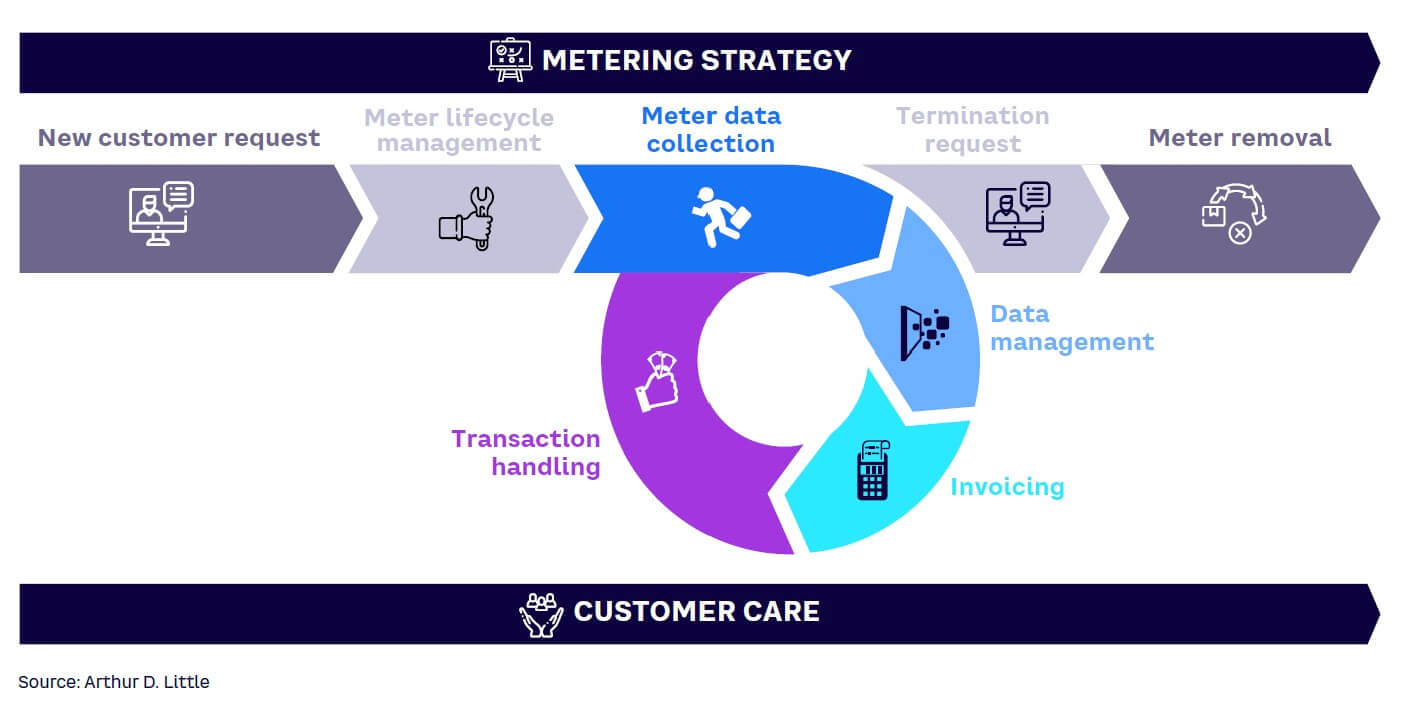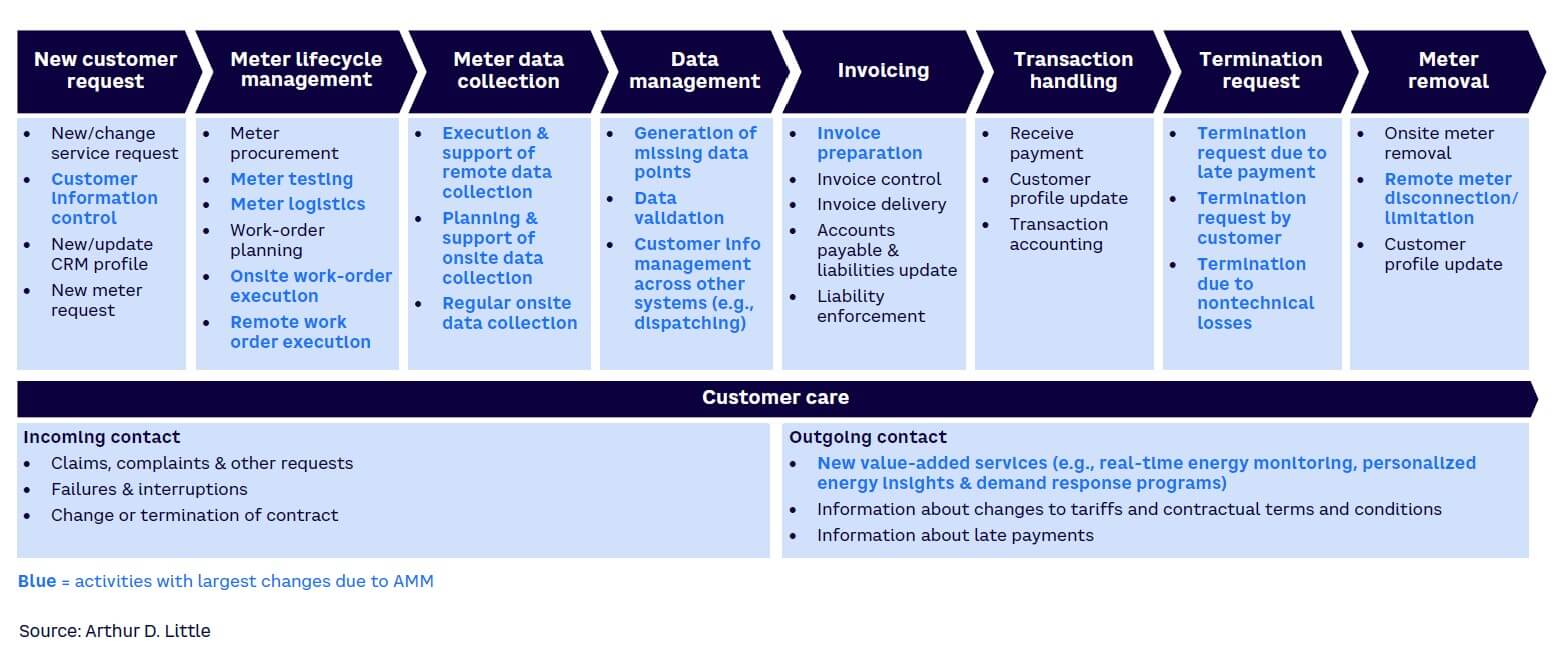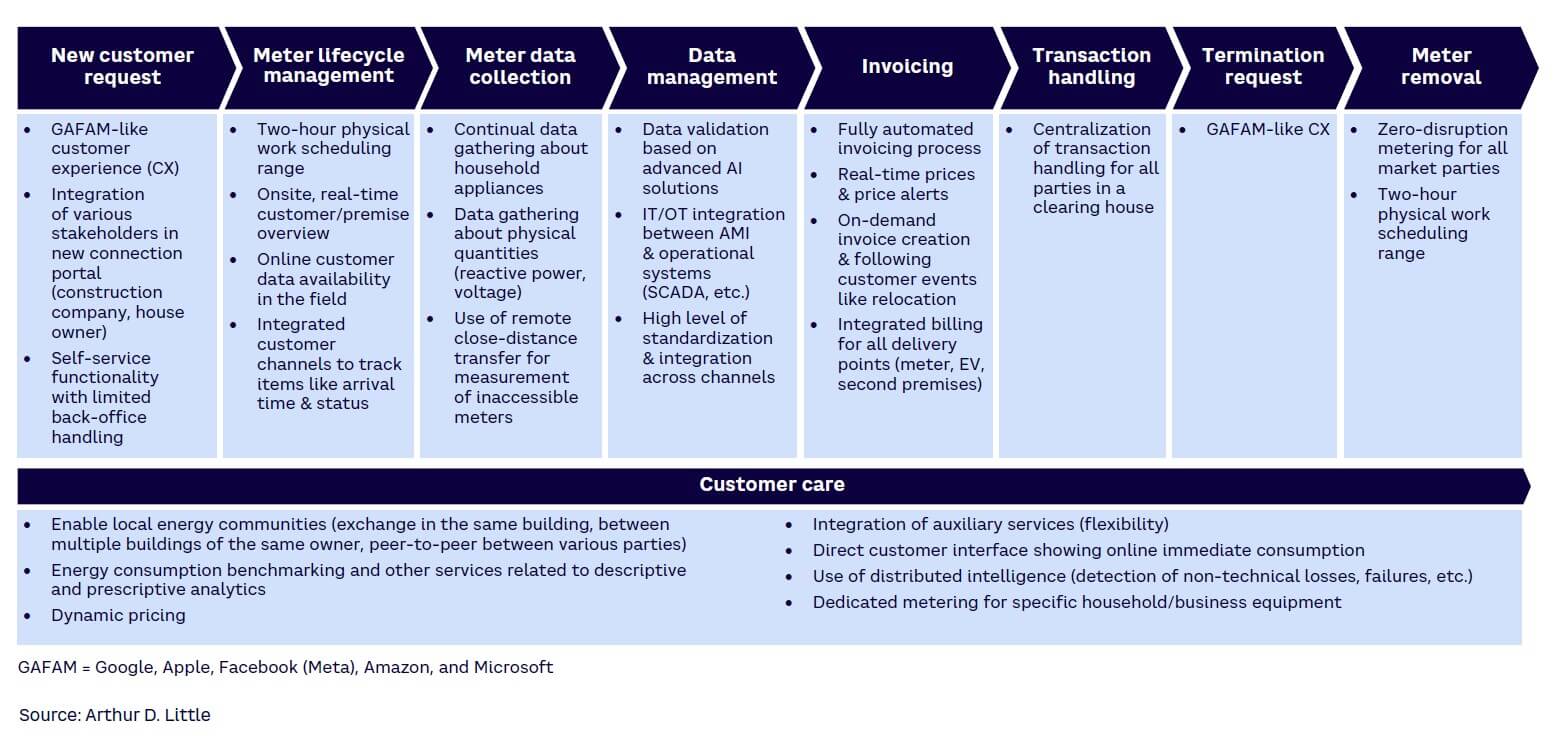
DOWNLOAD
DATE
Contact
Advanced metering management (AMM, or smart metering) is an increasingly common energy management tool in West European countries. Sweden, Spain, and Estonia have deployed smart meters nationwide, and the Netherlands and Italy are on their second generation of installation. Opportunities from dynamic pricing and demand-side management are widely acknowledged, but the transformation of distribution system operator (DSO) operating models is often overlooked. This brings benefits such as grid optimization, improved infrastructure planning, streamlined operations, and enhanced customer services — which build a more efficient, resilient, customer-centric energy system.
METER-TO-CASH MANAGEMENT
The importance of metering in utility systems cannot be overstated. It is the critical process through which end customers are billed for their energy consumption and/or production. In the European model, this typically falls under the jurisdiction of DSOs. This places them in the unique position of being a bridge between customers (both households and businesses) and energy suppliers, which use the meter reads provided by the DSOs to generate customer bills.
As a critical part of the energy ecosystem, the metering process is subject to myriad regulations, both at the national and European levels. These regulations ensure that the metering process is fair and accurate, customers are not overcharged, data collected is secure, and customer privacy is respected.
Metering is also a key component of the smart grid. Smart metering devices are increasingly being used to provide customers with more detailed information about their energy consumption and to help DSOs better manage the grid. This makes the grid more efficient and reliable and ensures that customers get the best possible service.
As shown in Figure 1, meter-to-cash (M2C) is a complex process that involves a variety of technologies and stakeholders and has a tremendous impact on the organizational structure and operating model of a DSO:
-
Customer care is a major part of the job, with customer-service teams responsible for all communications between the DSO and customers (e.g., requests, complaints, and questions).
-
Meter lifecycle management is another important area; the team is responsible for meter testing, logistics, installation, maintenance, and long-term planning.
-
Data collection involves both on-site visits to gather data from non-remote meters and remote data collection.
-
Data management is the process of validating gathered data, investigating anomalies, and handling data complaints.
-
Invoicing follows, with the team responsible for preparing invoices for energy suppliers and end-customers.
-
Transaction handling involves handling incoming and outgoing transactions, as well as monitoring account receivables.

Because of these complexities, the metering process must be well-defined and standardized, with clear roles and responsibilities for each step and close integration with other DSO systems and processes.
Meter lifecycle management, including asset management and dispatching, are also significantly impacted by the reach and accuracy of metering technology. Asset managers must pay close attention to the age, performance, installation, calibration, and compliance of each meter, which range from tens of thousands to millions depending on the size of the DSO. Meter data is used in energy-flow analyses, nontechnical loss identification, and demand-side management to ensure that the grid is run optimally and that areas needing additional investment or maintenance are identified. Metering technology significantly impacts DSOs, so any major technology change will have far-reaching implications.
SWITCHING TO REMOTE METERING
Above all else, accuracy in all metering data collected by DSOs is paramount, as any miscalculation can put them in a position of liability, potentially culminating in a legal battle. The stakes are particularly high for large industrial customers: an incorrect invoice can result in losses of millions of euros. To ensure accuracy, DSOs are transitioning from error-prone, traditional yearly/monthly meter readings to a semi-continuous remote metering system, commonly known as AMM or smart metering. Smart metering lets customers receive notifications and updates in real time and gives DSOs access to current information about customer energy consumption. With smart metering technology, DSOs can be confident their metering data is accurate and reliable.
When a DSO undertakes a change in metering technology or processes, it’s likely to have significant, lasting impacts on the organization. Figure 2 shows all the activities that must be altered when a standard analog meter is exchanged for a remotely read smart meter.

A series of major changes must be implemented to ensure that the DSO’s M2C-related functions are up to date:
-
With customer care, they must offer semi-online data points, as well as services related to analytics, new tariffs, and equipment-specific metering.
-
Metering must be optimized to include remote work orders, testing and parametrization of higher number of variable data inputs, and communications technology implementation.
-
Data collection will move away from manual processes, and data management must be prepared to accommodate 15-minute data intervals and to shift its focus to more advanced analytics with the automation of data validation.
-
Invoicing depends on whether dynamic pricing tariffs are implemented; cash management remains unchanged.
As the shift toward smart metering gathers momentum, companies should prepare for an overhaul of the IT infrastructure needed to support it. The amount of incoming data increases by a factor of 35,000x, as 15-minute intervals are recorded hourly, compared to single values for the year or month. Moreover, new data points like power-quality reads/intervals, events, and meter network performance can be communicated, resulting in even higher data levels.
This calls for increased capacity in the data management system, which must flawlessly transfer data to and from other systems, such as dispatching, customer relationship management (CRM), and customer portal/app.
Smart metering offers several benefits and risks for DSOs that must be managed effectively to ensure successful implementation and operation.
Risks of smart metering for DSOs include:
-
Cybersecurity. Smart meters and associated communications networks can be vulnerable to cyberattacks. DSOs must ensure that appropriate cybersecurity measures are in place to protect meter data and communications networks, both for privacy and business continuity.
-
Data privacy. Smart meter data contains sensitive information about customer energy consumption that must be protected according to data privacy regulations.
-
Interoperability. Smart metering infrastructure can be complex and heterogeneous, requiring standardization and interoperability to ensure seamless integration with other systems and devices.
-
Implementation costs. Implementing smart metering can be costly, requiring significant investment in infrastructure, software, and staff training.
-
Technical challenges. Smart metering can present technical challenges related to communications networks, meter installation, data management, and analytics.
-
Rapid obsolescence. Smart metering technology is continuously evolving, with new features, capabilities, and standards being introduced regularly. DSOs should carefully assess technologies they plan to implement to ensure they align with industry standards and are capable of supporting future advancements.
Benefits of smart metering for DSOs include:
-
Improved network planning. Smart meter data can help DSOs better plan their networks by providing insights into energy consumption patterns and demand peaks. This information can be used to optimize network capacity, prevent overloading, and reduce the need for costly infrastructure upgrades.
-
Enhanced grid management. Smart meters can help DSOs manage their grids more effectively by providing real-time data on energy flows and grid performance. This information can be used to quickly detect faults and outages, improve network resilience, and reduce downtime.
-
Increased energy efficiency. Smart meter data can help DSOs identify energy waste and implement energy-saving measures. This can help reduce overall energy consumption and carbon emissions, which is crucial in the context of the climate crisis.
-
Better customer service. Smart meters provide customers with real-time information on their energy consumption, which can help them better manage their energy usage, lower their monthly bills, and improve overall satisfaction with the DSO.
-
Cost savings. Smart metering can help DSOs reduce costs by streamlining metering operations, shifting employees away from mundane and repetitive tasks and reducing the need for manual meter reading.
-
Integration of distributed energy resources (DERs). Smart metering plays a crucial role in the integration of renewable energy sources, electric vehicles, and other DERs into the grid. By monitoring and managing the generation and consumption of distributed energy resources in real time, DSOs can optimize grid integration, balance supply and demand, and facilitate effective feed-in tariff programs.
The combination of efficient DSO operating models and robust M2C processes supported by smart metering brings significant benefits, such as operational efficiency, grid reliability, customer engagement, and financial optimization. These factors contribute to a more sustainable, reliable, customer-centric energy system.
BEST PRACTICES FROM SMART METERING PIONEERS
Organizations in the midst of smart meter rollouts or preparing for one can look to the pioneers in the smart metering space for guidance. As Figure 3 highlights, these best practices have a profound impact on the M2C process and the customer care that accompanies it.

Several key best practices are emerging:
-
Consumer engagement. Utilities are adopting customer-centric approaches to encourage consumers to participate in energy conservation programs and understand their energy-consumption habits.
-
Customer self-service portals and apps. Customer self-service portals and mobile applications let customers view their energy usage, bills, and payment history online, giving customers more control over their accounts.
-
Advanced metering infrastructure (AMI). AMI is a comprehensive network of smart meters, communications networks, and data management systems that enable two-way communication between utilities and customers, providing utilities with access to real-time data.
-
Big data analytics. Big data analytics involves the use of advanced analytical tools to process and analyze large volumes of data generated by smart meters.
-
Demand response (DR) programs. These are designed to incentivize customers to reduce energy consumption during periods of peak demand, leading to less stress on distribution networks and fewer blackouts.
-
Renewable energy integration. Smart meters can help optimize the integration of renewable energy sources into the grid, improving energy efficiency and reducing greenhouse gas emissions.
-
Digital technology adoption. Artificial intelligence and machine learning can help utilities better manage their distribution networks, optimize energy usage, and improve billing accuracy.
In addition to the emergence of best practices, a gradual shift toward next-generation meter rollouts has begun. Figure 4 shows how this is playing out in the Netherlands. It is mainly driven by:
-
A modular asset approach to extend the lifetime of deployed smart meters in line with fast-evolving technologies that can easily be integrated without having to replace the full meter.
-
The need for DSOs to better control feature development, ensuring faster time to market and less dependence on incumbent OEMs.
-
Requirement of local (real-time) direct meter data disclosure to (non-)traditional market parties without having to send and process the data over DSO-managed metering platforms with resulting delayed delivery times (often D+1 or D+2). This increase in energy data demand is driven by the emergence of value-added use cases being developed in the context of new energy services on top of traditional commodity revenues.

Conclusion
CAPTURING VALUE WITH SMART METERING
Smart metering is a game changer for the utility industry, revolutionizing the gathering and use of data. Fortunately, organizations can look to previous rollouts to develop their strategies and increase the chance of success. As they do, they should remember that smart metering isn’t just about technical prowess; it’s an important way to increase customer satisfaction and build brand loyalty. Despite the operating model challenges involved with switching to smart meters, the changeover offers DSOs five important opportunities for cost optimization and a focus on adding value:
-
As sensors and devices are added, the grid becomes more intelligent, allowing for more accurate monitoring and control.
-
The operational model shifts from reactive to proactive, stimulating more efficient operations and better customer service.
-
The focus shifts from cost optimization to value creation, with the organization able to identify and capture new market opportunities.
-
Data management shifts away from routine data validation and missing data tasks to advanced data analytics, which helps organizations identify new trends and nontechnical losses.
-
Organizations can move away from traditional business models and explore new opportunities, such as energy storage, DR, and distributed energy resources.
Smart metering is much more than a way to help customers better manage their energy consumption. It is a powerful tool that can revolutionize the energy sector and transform DSO operating models. DSOs should consider these three strategic actions to capture opportunities:
-
Define a clear vision and strategy for leveraging smart metering to transform operations. This involves understanding the potential benefits, setting goals and objectives, and outlining a roadmap for implementation. The strategy should align with the organization’s long-term goals and address key areas like grid optimization, customer engagement, and operational efficiency.
-
Invest in scalable, interoperable systems that can handle increased data volumes and enable seamless integration with other utility systems.
-
Prioritize customer-centric approaches by developing innovative services like real-time energy monitoring, personalized energy insights, and DR programs.


